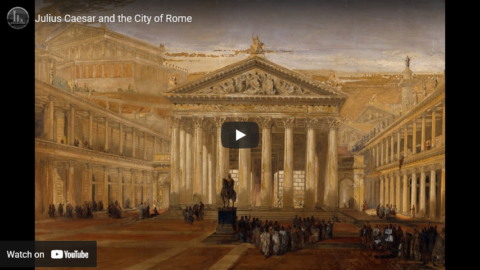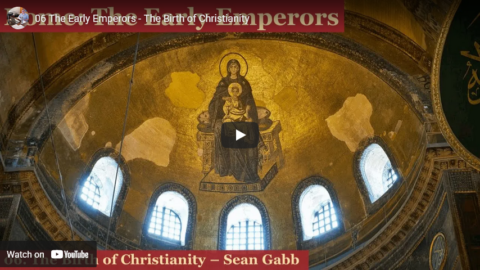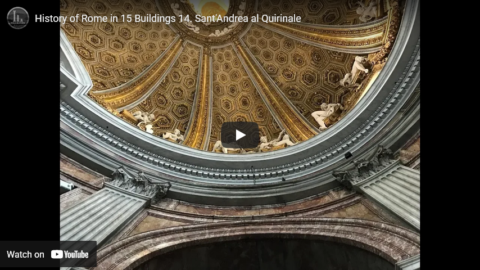seangabb
Published 1 May 2021In 400 AD, the Roman Empire covered roughly the same area as it had in 100 AD. By 500 AD, all the Western Provinces of the Empire had been overrun by barbarians. Between April and July 2021, Sean Gabb explored this transformation with his students. Here is one of his lectures. All student contributions have been removed.
(more…)
July 23, 2022
Barbarian Europe: Part 3 – Barbarism and Christianity
July 18, 2022
QotD: The basis of belief in pre-modern polytheistic societies
 For the Roman (or most any ancient polytheist) there is never much question of if the gods exist. True atheism was extremely rare in the pre-modern world – the closest ancient philosophy gets to is Epicureanism, which posits that the gods absolutely do exist, but they simply do not care about you (the fancy theological term here is immanence (the state of being manifest in the material world). Epicureans believed the gods existed, but were not immanent, that they did not care about and were little involved with the daily functioning of the world we inhabit). But the existence of the gods was self-evident in the natural phenomena of the world. Belief was never at issue.
For the Roman (or most any ancient polytheist) there is never much question of if the gods exist. True atheism was extremely rare in the pre-modern world – the closest ancient philosophy gets to is Epicureanism, which posits that the gods absolutely do exist, but they simply do not care about you (the fancy theological term here is immanence (the state of being manifest in the material world). Epicureans believed the gods existed, but were not immanent, that they did not care about and were little involved with the daily functioning of the world we inhabit). But the existence of the gods was self-evident in the natural phenomena of the world. Belief was never at issue.
(This is, as an aside, much the world-view we might expect from a universe – as is often the case in speculative fiction or high fantasy – where divine beings are not merely immanent, but obviously so, intervening in major, visibly supernatural ways. The point at which this or that supernatural, divine being brings someone back to life, grants them eternal youth or makes swords light on fire ought to be a pretty substantial theological awakening for everyone there. Even for other polytheists, such displays demand the institution of cult and ritual.)
This, of course, loops back to one of my favorite points about history: it is generally safe to assume that people in the past believed their own religion. Which is to say that polytheists genuinely believe there are many gods and that those gods have power over their lives, and act accordingly.
In many ways, polytheistic religions, both ancient and modern (by modern polytheisms, I mean long-standing traditional religious structures like Hinduism and Shinto, rather than various “New Age” or “Neo-pagan” systems, which often do not follow these principles), fall out quite logically from this conclusion. If the world is full of gods who possess great power, then it is necessary to be on their good side – quite regardless of it they are morally good, have appropriate life philosophies, or anything else. After all, such powerful beings can do you or your community great good or great harm, so it is necessary to be in their good graces or at the very least to not anger them.
Consequently, it does not matter if you do not particularly like one god or other. The Greeks quite clearly did not like Ares (the Romans were much more comfortable with Mars), but that doesn’t mean he stopped being powerful and thus needing to be appeased.
So if these polytheistic religions are about knowledge, then what do you need to know? There are two big things: first you need to know what gods exist who pertain to you, and second you need to know what those gods want.
Two things I want to pull out here. First: the exact nature and qualities of the gods do not really matter, because remember, the goal is practical results. Crops need to grow, ships need to sail, rain needs to fall and the precise length of Zeus’ beard is profoundly unimportant to those objectives, but getting Zeus to bring storms at the right times is indispensable. The nature of the gods largely does not matter – what matters is what you need to do to keep them happy.
Second, you may be saying – you keep ramming home the idea that you have to cultivate all of the gods – what is this “pertaining to you” business? What I mean by this is that while the polytheist typically accepts the existence of vast numbers of gods (often vast beyond counting), typically only a subset of those gods might be immediately relevant. Some gods are tied to specific places, or specific families, or jobs, or problems – if you don’t live in that place, belong to that family, hold that job, etc., then you don’t need to develop a relationship with that god.
Nevertheless, everyone typically needs to develop a relationship with the big gods – the sort whose name you know from a high school or college class – that control big parts of life we all share, along with a bunch of smaller gods which pertain to smaller parts of our lives or perhaps only to select groups of people (we’ll talk more about these “little” gods later in this series, because they are fascinating).
Bret Devereaux, “Collections: Practical Polytheism, Part I: Knowledge”, A Collection of Unmitigated Pedantry, 2019-10-25.
July 16, 2022
Declarations of faith in the Church of Scientism
Chris Bray points out the hard-to-miss similarities between traditional religious beliefs and the modern beliefs of the congregations of the Church of Scientism:
Christian churches tend the bust out the HE IS RISEN banner on Easter Sunday, and here’s a version of the central declaration of faith from another religion, the Church of Scientism:
“We stand by science, so we stand by the vaccine.” These hang from every lamppost on the sizeable campus of a major research hospital in Los Angeles, an identical recitation of faith that appears before the eyes of the medical pilgrim every thirty steps or so. You can chant it in a rhythm, if you’re so inclined, as ye performest thine Stations of the Vaccine. The true penitent will park on Robertson, to walk past the maximum number of signs, but mark ye the parking restrictions, for the ways of Los Angeles parking enforcement are cruel, and many are they who suffer the penalties.
If this isn’t a declaration of a faith, then what is it? The call and response, the this-therefore-this:
Priest: Because of science, we save lives every day.
Congregation: We stand by science, so we stand by the vaccines.
You can hear the chanting in your head, can’t you? The repetition, the delivery of a mantra in a form that allows you to perceive it, and perceive it, and perceive it, and perceive it yet again before ye makest thine turn onto San Vicente. When you say it often and identically, it wears grooves; it patterns the dailiness of life with the avenues of belief. It’s Benedictine Scientism.
Or, you know, not. My bet is that most people never notice these signs, or never notice them twice, but the choice to make them and to display them is compellingly bizarre and creepy. I wish I could have witnessed the meeting of medical administrators that led to that choice, because I’m fairly confident that it played like a Paddy Chayefsky movie IRL.
I’ve been reminded over and over this week how important Substack has become. This absolute must read post from el gato malo discusses the complete implosion of popular trust in the mRNA injections, from the sharp decline in booster uptake to the “that parrot is dead” numbers regarding mRNA uptake in children under the age of five. Flatly, people aren’t taking this shit anymore, and they’re for damn sure not having it injected into their children.
July 11, 2022
Well, we were overdue for another “Great Awakening”, but this time it’s woke
In the Neo-Ciceronian Times, Theophilus Chilton outlines why it’s more sensible to regard today’s progressives as devout cultists rather than persuaded political activists:
You may not have been aware of it, but a religious revival has been sweeping America for the past few years. However, rather than the old-time religion of Christian piety, it’s a new religion with new idols and a new direction. Yet, not entirely new — it’s the latest phase in an evolving revolutionary belief system that has consciously set itself against every aspect of traditional American culture and society. Whereas earlier progressivism made an effort to appear to integrate itself into earlier American paradigms even as it was acting to overturn them, the current religion of Woke Progressivism has completely excised itself from any pretension of respect for previous Americanism.
Some on the Right balk at the terminology of referring to woke progressivism as a “religion”. After all, hasn’t the modern Left been characterised by a rejection of religion? By an increasingly overt atheism that not only denies traditional religion, but actively subverts and mocks? Yet, unlike European modes of leftism that have remained more within the boundaries of orthodox Marxism-Leninism, official atheism has never been able to gain more than a toehold in the United States. The American temperament is a religious one and therefore requires some object of piety towards which it is directed.
For the Left, this new object of piety was channeled into cultural Marxism, a form of New Leftism that has successfully managed to take over nearly every institution — government, corporate, cultural — in this country. It did so by providing a more comprehensive program, one that was as much cultural subversion and replacement as it was “traditional” economic leftism, than older forms of socialism. This new leftism, which in its full floruit is the woke progressivism we see today, provides a totalising replacement ideology that seeks to sweep away everything that came before it.
But is this new belief system a religion? I believe that it definitely can be thought of as one, since it displays all the typical sociological patterns found in religions as they have been found throughout history, plus a few that are typical of cult groups as they’re observed today.
To begin, woke progressivism has a precisely defined and systematically enforced body of doctrines which are to be believed, not rationalised. The fluidity of gender, the naturalness of homosexuality, the evil of whiteness — all of these and much more are to be received by simple faith. But these aren’t randomly chosen. They have overarching doctrinal bases that fit within the larger progressive ideological agenda. Put together, these constitute an interlocking body of progressive doctrine that provides a comprehensive ideology to its followers.
Yet at the same time, woke progressivism does have a means of receiving new revelation and new interpretation via its own body of canonical authorities who then pass on this doctrine to the larger body of the woke “church”. This is done primarily through means of the narrative-shaping performed by major media outlets working in conjunction with elements within government, NGOs, and academia (the complex of which is what neoreactionaries often refer to as “the Cathedral”). Indeed, that process has been at work for decades — e.g. it is how the Afrocentrism of the 1980s went from being an odd, laughable academic quirk to being received doctrine which naysaying can cause you to lose your job. Have you ever noticed how when some new element of the progressive narrative hits, whether it’s a fundamental element of ideology or simply how to think about some current news event, that progressives seem to adopt it all at once?
There’s a reason for that. Once a change or addition is decided, the doctrine is swiftly promulgated to all of the local parishes and becomes a received and accepted part of the faith.
July 7, 2022
QotD: Predestination
Credo quia absurdum est has a long and shameful pedigree. See, for example, the notion of Predestination. Technically, “double predestination” is the absurd part — the idea that God must’ve decided who was going to Hell long before He even created the world. It’s all but impossible to teach this idea to students, because modern people — to their credit, and for once I’m not being sarcastic when crediting modern people with anything — realize how ball-scratchingly stupid that is. Hell, maybe it’s true, but no sane person can possibly live with it.
Modern people see that as carte blanche to do whatever we want, because hey, if we do it, God made us do it … which, if you think about it for half a second, means God Himself is responsible for “sin” (quotation marks necessary, because it can’t be evil if I have no possible choice in the matter). Calvin, Knox, et al thought of that too, of course — they were crazy, not stupid — and they even had an answer: Shut up, that’s why. Not the most theologically sophisticated reasoning, but when you’re being burned at the stake for Arminianism it’s remarkably persuasive. Meanwhile, you’d best live like the holiest Puritan that ever lived … even though it’s exquisitely pointless, because you’re almost surely damned.
Severian, “Public Piety”, Rotten Chestnuts, 2019-01-29.
July 5, 2022
Julius Caesar and the City of Rome
toldinstone
Published 14 May 2021Julius Caesar was not only a gifted general and fiercely ambitious politician. He was also a great builder, who reshaped the heart of Rome in his own image.
For much more on Caesar and his successors, check out my book Naked Statues, Fat Gladiators, and War Elephants: Frequently Asked Questions about the Ancient Greeks and Romans.
https://www.amazon.com/Naked-Statues-…
If you’re so inclined, you can follow me elsewhere on the web:
https://www.patreon.com/toldinstone
https://www.reddit.com/r/AskHistorian…
https://www.instagram.com/toldinstone/
https://www.goodreads.com/author/show…0:00 Introduction
1:29 The Forum in Caesar’s time
3:30 Caesar’s new forum
4:42 The Temple of Venus Genetrix
5:37 The Basilica Julia
6:10 The Curia and Rostra
6:57 Dedication games
8:02 Caesar the godThanks for watching!
July 3, 2022
David Warren waves the flag
As noted the other day, the official period of mourning sickness that enveloped Canada last year after the blockbuster revelations about residential schools has not been followed-up by any substantive proof of any of the sensational claims that Prime Minister Trudeau seized upon to lecture Canadians about our historical guilt (the “genocideal nation” that he claimed we were) and to haul the national flag down to half-staff for half a year. David Warren chooses to wave the flag instead:

Justin Trudeau has always had a strong affinity for the symbolic gesture, especially when the media are around to record it.
The latest trick in what we might call “eco-commie-perv agitprop”, emerged while shaming Canadian history and traditions. I’ll touch on it in a moment. It is a product chiefly of the Indian Wars of the last few years. The White Man, and more specifically when Catholic, has been accused of massacring the Native People in 20th-century residential schools, just as he did upon coming to the continent. He then ploughs the anonymous victims into mass graves, showing his affinity to, exempli gratia, the Nazis.
This propaganda campaign, which quickly reached the tedious stage, was founded on a series of oft-repeated unambiguous lies, driven into our susceptible children in our compulsory public schools, and throughout life by such agencies as the CBC. (All our significant media are now under government control, subsidy, and watch.) White men, especially the Catholics, contaminate Canadian history by their Satanic essence, according to this malicious fantasy. Goodness and innocence can be found only in their victims, the “visible minorities” (or majorities, as the case may be). Shame is inculcated among persons exhibiting the wrong race.
I write of Canada, but something similar is happening in the United States, and has been carried to Europe on the sails of Hollywood and popular “music”. Canada is, however, an extreme example — of brazen idiocy — and even to underprivileged (all-white) rural places the message is piped in. Disharmonious voices must expect state interference, and eventual arrest.
For Canada now has political prisoners, including many who participated in the Freedom Convoy of truck drivers. Tamara Lich, a prominent organizer of this demonstration, has been gratuitously jailed, though she didn’t even try to commit a plausible crime. This week she was gaoled again, apparently for receiving a freedom medal. (Persons it was in her bail conditions not to meet may have been in the audience.) She was put out of sight for “Canada Day” (the former Dominion celebration, yesterday). This manipulation of Canadian law is, sadly, no longer unprecedented. It seems to be ordered directly from the Prime Minister’s Office.
July 1, 2022
Trying to reconcile the highly mediagenic “Residential School mass graves” stories with facts-on-the-ground
Prime Minister Justin Trudeau — never one to miss opportunities to preen before the camera and shed a performative tear or two — quickly ordered Canadian flags to half-staff when the stories about unmarked graves on the grounds of former residential schools spread across the world. Claims and accusations flew, based on ground-penetrating radar scans that didn’t actually prove that the surveyed land contained lost graves. Once the narrative was established, it provided many opportunities for First Nations organizations, activists, and Canadian and foreign politicians to moralize, condemn, and demand investigations, restitution, and apologies from the Catholic church (which ran over 40% of the residential schools), and the provincial and federal governments.
So, more than a year later … what has been investigated? Not much, it turns out:
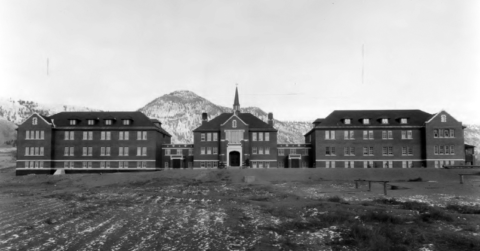
Kamloops Indian Residential School, 1930.
Photo from Archives Deschâtelets-NDC, Richelieu via Wikimedia Commons.
Sixty-eight Christian churches, mostly Roman Catholic, were vandalised or even burned to the ground. Many of these were historical church buildings still used and revered by native people. The pretext for arson and vandalism was that the Kamloops Indian Residential School had been run by a Catholic religious order, as had 43% of all residential schools. Imagine the outrage if 68 synagogues or mosques had been vandalised and burned. Yet the attacks on 68 Catholic churches passed with only mild criticism.
An article in the New York Times was typical of media commentary about the unmarked graves. It was first published under the headline “Horrible History: Mass Grave of Indigenous Children Reported in Canada” on 28 May and updated on 5 October under the same title. It asserted that: “For decades, most Indigenous children in Canada were taken from their families and forced into boarding schools. A large number never returned home, their families given only vague explanations, or none at all.”
Because the corporate press take their cue from the New York Times, its perspective echoed widely. The discovery of the so-called unmarked graves was chosen by Canadian newspaper editors as the “news story of the year”. And the World Press Photo of the Year award went to “a haunting image of red dresses hung on crosses along a roadside, with a rainbow in the background, commemorating children who died at a residential school created to assimilate Indigenous children in Canada”.
But the award this news report should have won is for fake news of the year. All the major elements of the story are either false or highly exaggerated.
First, no unmarked graves have been discovered at Kamloops or elsewhere. GPR has located hundreds of soil disturbances, but none of these has been excavated, so it is not known whether they are burial sites, let alone children’s graves. At her original press conference, the Chief of the Kamloops Indian Band called these findings unmarked graves, and the media, politicians, and even Pope Francis ran with the story without waiting for proof.
Similar claims from the chiefs of other Indian reserves ran into grave difficulty (no pun intended) because the GPR research was conducted in whole or in part on community cemeteries located near the sites of residential schools. It would hardly be surprising to find burial sites in a cemetery! But again, since no excavations have been conducted, it is not known whether these unmarked graves contain the bodies of children.
North American Indians did not conduct burials; they usually exposed the bodies of the dead to be worn away by predators and the elements. Christian missionaries introduced the practice of burial. But Indian graves were usually marked by simple wooden crosses that could not long withstand the rigours of Canadian weather. Thus Indian reserves today contain probably tens of thousands of forgotten unmarked graves of both adults and children. To “discover” these with ground-penetrating radar proves nothing without excavation.
Second, there are no “missing children”. This concept was invented by the Truth and Reconciliation Commission (TRC), whose members spoke at various times of 2,800 or 4,200 Indian children who were sent to residential schools but never returned to their parents. Indeed, some children died at residential schools of diseases such as tuberculosis, just as they did in their home communities. But the legend of missing students arose from a failure of TRC researchers to cross-reference the vast number of historical documents about residential schools and the children who attended them.
The Early Emperors – Part 6: The Birth of Christianity
seangabb
Published 27 Dec 2021The Roman Empire was the last and the greatest of the ancient empires. It is the origin from which springs the history of Western Europe and those nations that descend from the Western Roman Empire. It is the political entity within which the Christian faith was born, and the growth of the Church within the Empire, and its eventual establishment as the sole faith of the Empire, have left an indelible impression on all modern denominations. Its history, together with that of the ancient Greeks and the Jews, is our history. To understand how the Empire emerged from a great though finally dysfunctional republic, and how it was consolidated by its early rulers, is partly how we understand ourselves.
Here is a series of lectures given by Sean Gabb in late 2021, in which he discusses and tries to explain the achievement of the early Emperors. For reasons of politeness and data protection, all student contributions have been removed.
More by Sean Gabb on the Ancient World: https://www.classicstuition.co.uk/
Learn Latin or Greek or both with him: https://www.udemy.com/user/sean-gabb/
His historical novels (under the pen name “Richard Blake”): https://www.amazon.co.uk/Richard-Blak…
June 30, 2022
QotD: Sparta had Lycurgus, while Athens had Solon … who at least actually existed
Lycurgus was the name the Spartans gave for their mythical founder figure, a Spartan who had supposedly lived in the late 9th century and had set up the Spartan society as we see it in the classical period. Almost all of our details for his life come from a biography by Plutarch, written c. 100 A.D. (date to be significant in a moment). The story the Spartans told went thusly:
Once upon a time … there was a Spartan named Lycurgus, and he was the very best Spartan …
Lycurgus had been the younger brother of one of Sparta’s two kings, but had left Sparta to travel when his brother died, so that he would be no threat to his young nephew.
After a time, the Spartans begged Lycurgus to come back and reorganize society, and Lycurgus – with the blessing of the Oracle at Delphi – radically remade Spartan society into the form it would have for the next 400 years. He did not merely change the government, but legislated every facet of life, from child-rearing to marriage, to the structure of households, the economic structure, everything. Once he had accomplished that, Lycurgus went back to Delphi, but before he left he made all the Spartans promise not to change his laws until he returned. Once the Oracle told him his laws were good, he committed suicide, so that he would never return to Sparta, thus preventing his laws from ever being overturned. So the Spartans never changed Lycurgus’ laws, which had been declared perfect by Apollo himself. Subsequently, the Spartans accorded Lycurgus divine honors, and within Sparta he was worshiped as a god.
And that’s how Lycurgus remade Sparta. The End.
The role Lycurgus serves in the sources is as the perfect, infallible founder figure. No less than the Oracle at Delphi – the divine word of Apollo – declared Lycurgus a god (Hdt. 1.65.3). For later sources who, we must stress – believe their own religion (as people everywhere are wont to do) – that means, essentially a priori that Lycurgus’ “constitution” must be practically flawless and all flaws must stem from its imperfect implementation.
But – wait a second – what is our evidence for the actual person of Lycurgus or the character of the state he set up?
Remember how I said Lycurgus is dated to the late 9th century – specifically the 820s B.C. or so. That’s a huge problem. The earliest Greek literature comes from around (very roughly – there is deep scholarly debate here that I’m glossing over) the mid-8th century (c. 750 or so) and is entirely mythological in nature. The first actual history is Herodotus, writing in the mid-400s. The earliest historical event we have evidence for is the Lelantine War (c. 700ish), at least a century after the life of Lycurgus. None of our sources have anything to go on about Lycurgus – save for what the Spartans – who already worship this figure as a god – tell them. Crucially, Tyrtaeus, writing in the 650s B.C., while he does mention the rhetra (an oracle the Spartans received concerning the arrangement of their government) does not mention Lycurgus (although Plutarch is quick to connect the two, Plut. Lyc. 6.5), meaning that the earliest source for Lycurgus’ existence is Herodotus.
Wait, it gets even better – the one thing we do know about Lycurgus’ laws is that they were not written down (Plut. Lyc. 13.1). Also, Lycurgus supposedly took steps to prevent his remains from returning to Sparta (Plut. Lyc. 29.5-6, but cf. 31.4) and no continued family line, which seems like exactly the sort of explanation you put at the end of a good campfire story for why there was absolutely no trace of such an important man save his legend. So not only the details of Lycrugus’ life, but also the society he created will have lived as oral tradition – potentially changing from one telling to the next, being embellished or expanded – for generations before being committed to the permanent, unchanging memory of written history.
In short, our only evidence for Lycurgus are the campfire stories told about him by people who worshiped him as a god, as related to individuals centuries later. Which is to say that, by historical standards, there is no reliable evidence at all that Lycurgus existed.
[…]
Lycurgus is often set against Solon – the early 6th century Athenian reformer. It is true that Athenians also tend to attribute things to Solon that were later developments, but we need to note the key differences: Solon comes two centuries after Lycurgus (thus, unlike Lycurgus, in the historical period), didn’t receive divine honors and most importantly writes to us (he wrote poetry, some of which survives), so that we can know he was an actual real person. Asking students – as I have seen done – to compare a real, flawed reformer with an idealized, semi-mythical demi-god without any kind of guidance as to the nature of these two figures is, quite frankly, educational malpractice.
Bret Devereaux, “Collections: This. Isn’t. Sparta. Part III: Spartan Women”, A Collection of Unmitigated Pedantry, 2019-08-29.
June 24, 2022
“… most of the ‘mental health crisis’ is just loneliness”
Ed West believes we’re suffering so many social ailments because we’re social creatures, evolutionarily speaking, and modern society has reduced or eliminated so many traditional community social gatherings — made far, far worse by arbitrary lockdown rules and harsh enforcement during the Wuhan Coronavirus panicdemic. He’s talking specifically about Britain and Europe, but the same definitely applies here in North America:
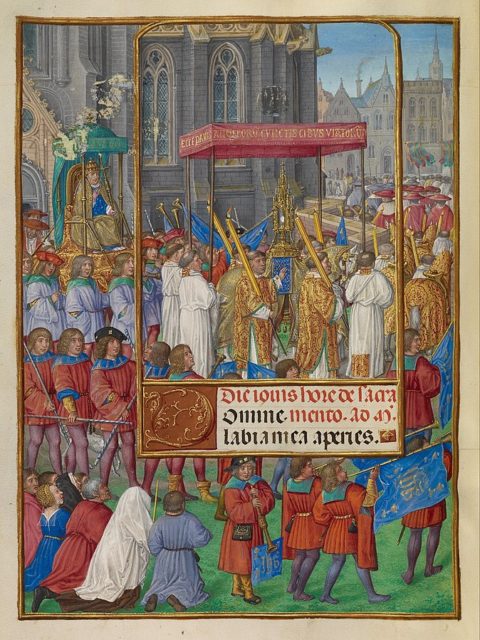
“Procession for Corpus Christi” attributed to Master of James IV of Scotland (Flemish, before 1465 – about 1541), illuminator.
Original illumination in the Getty Center Collection via Wikimedia Commons.
Last week, for example, most of continental Europe got a holiday to mark Corpus Christi, once a huge event in England but killed off by the Reformation. Why can’t we have a holiday too? It was 27 degrees in London last Thursday — it would have been great.
We’re all aware, on some subconscious level, that there is a need for communal feasts and holidays, and in some ways the idea of a June procession to celebrate the official religion has made a comeback with Pride. The feast-shaped hole in our lives is why, from time to time, the great and the good come up with very boring ideas for substitutes feasts, the latest being “Celebration Day”. The idea is for “one day in the year when we can all take a pause in our busy lives to reflect, remember and celebrate the lives of people no longer here”. You mean, like the feast of All Saints’ and All Souls’, which again was a huge part of our calendar once and is still marked in Catholic countries? Like that one?
[…]
Contrary to the fashionable Noughties takes about the evils of supernatural belief, religion has huge psychological benefits. There is a vast array of evidence showing that attending religious ceremonies increases dopamine responses in the brain. Overcoming our fear of death is not even the key part; it is meeting other people and taking part in a common ritual, which has huge benefits, including reduced risk of suicide or addiction. Religious attendance is “associated with lower psychological distress” and “related to higher well-being”.
Modernity, diet and substance abuse may have slightly increased rates of extreme mental illness such as schizophrenia, while social media has allowed people with personality disorders to become prevalent, especially in politics. But most of the “mental health crisis” is just loneliness. People attend fewer communal events because of the decline of religion, they see other people less regularly and they have fewer friends — of course they’re unhappy! Humans are not just social mammals, we are ultra-social by the standards of other species; that’s why we need common rituals and why we’re chasing that religious feeling everywhere and can’t find it. It is why, as Madeline Grant wrote in the Telegraph this week, that as well as progressive institutions adopting religious-type feasts, even exercise classes increasingly resemble Mass.
Lockdown, traumatic though it was, was merely an extreme version of the trend towards solitude already underway (with working from home, online shopping and various other lockdown activities on the rise before 2020). Most traditional societies would consider our everyday lives in non-Covid times to be a form of lockdown, with historically very unusual levels of isolation. That is why the extreme loneliness of lockdown gave rise to ersatz rituals such as Clap for Carers.
Yet you just can’t beat the real thing. As Parker wrote at the time, ritual decline was a real sadness in our lives: “From the Middle Ages until the first half of the 20th century, Whitsun and the week that followed was the chief summer holiday of the year in Britain. It was a time for all kinds of communal merry-making, varying over the centuries but consistent in spirit: the season for feasts and fairs, dancing and drinking, school and church processions, and generally having a good time.”
June 22, 2022
The Day the Viking Age Began
Tasting History with Max Miller
Published 21 Jun 2022For 15% off your first order with Porter Road, click the link https://porterroad.com/MAXMILLER
VIKING BLOD MEAD: https://bit.ly/meadandmore
Support the Channel with PATREON ► https://www.patreon.com/tastinghistory
Merch ► https://crowdmade.com/collections/tas…
Instagram ► https://www.instagram.com/tastinghist…
Twitter ► https://twitter.com/TastingHistory1
Tiktok ► TastingHistory
Reddit ► https://www.reddit.com/r/TastingHistory/
Discord ► https://discord.gg/d7nbEpy
Amazon Wish List ► https://amzn.to/3i0mwGtSend mail to:
Tasting History
22647 Ventura Blvd, Suite 323
Los Angeles, CA 91364LINKS TO SOURCES**
An Early Meal by Daniel Serra & Hanna Tunberg: https://amzn.to/3MOJSNb
Anglo Saxon Chronicle: https://amzn.to/3tBBoCx
The Oxford History of the Vikings by Peter Sawyer: https://amzn.to/3zElwmlRECIPE
1 pound (½ kg) pork meat
Salt for seasoning
2 tablespoons (25g) Lard or another oil for cooking
1 ½ cups (125g) chopped spring onion, or leek
2 teaspoons brown mustard seeds, roughly crushed
1 teaspoon chopped mint
1 pound (½ kg) fresh berries
½ cup (120ml) water
½ cup (120ml) mead1. Season the meat, then heat the lard/oil in a pot on the stove. Sear the meat for 5-7 minutes until well browned. Then remove it and set aside.
2. Add the onion to the pot and cook for 2-3 minutes, then add the water and mead and bring to a simmer. Add the mustard seed and mint and return the pork to the pot. Return to a simmer then cover the pot and place it in an oven at 325°F/160°C for 15-25 minutes or until the pork reaches 145°F. Then remove the pot from the oven and remove the pork to let it rest.
3. Add the berries into the pot with the braising liquid and cook on the stove for 7-10 minutes or until very soft. Mash the berries, then pour everything through a strainer. Return the liquid to the pot and simmer for several minutes or until the sauce reduces down. The sauce will not become too thick without the addition of starch (optional).
4. Slice the pork and serve with the sauce, extra berries, and mint.
**Some of the links and other products that appear on this video are from companies which Tasting History will earn an affiliate commission or referral bonus. Each purchase made from these links will help to support this channel with no additional cost to you. The content in this video is accurate as of the posting date. Some of the offers mentioned may no longer be available.
Subtitles: Jose Mendoza | IG @worldagainstjose
PHOTO
Lindisfarne Priory: Mstanyauk, CC BY-SA 3.0 https://creativecommons.org/licenses/…, via Wikimedia Commons
Disneyland: Sean MacEntee via Flickr, CC BY-SA 3.0 https://creativecommons.org/licenses/…, via Wikimedia Commons
France Relics: Dennis Jarvis via Flickr, CC BY-SA 3.0 https://creativecommons.org/licenses/…, via Wikimedia Commons
Holy Island Sunrise (again): By Chris Combe from York, UK – CC BY 2.0, https://commons.wikimedia.org/w/index…
Viking Age Map: By en:User:Bogdangiusca – Earth map by NASA; Data based on w:File:Viking Age.png (now: File:Vikingen tijd.png), which is in turn based on http://home.online.no/~anlun/tipi/vro… and other maps., CC BY-SA 3.0, https://creativecommons.org/licenses/…” rel=”noopener” target=”_blank”>https://commons.wikimedia.org/w/index…
Lindisfarne Priory Ruins: Nilfanion, CC BY-SA 3.0 https://creativecommons.org/licenses/…, via Wikimedia Commons
Statue of Rollo: By Delusion23 – Own work, CC BY-SA 4.0, https://commons.wikimedia.org/w/index…MUSIC
Battle of the Creek by Alexander Nakarada (www.serpentsoundstudios.com)
Licensed under Creative Commons BY Attribution 4.0 License
http://creativecommons.org/licenses/b…#tastinghistory #viking
June 21, 2022
History of Rome in 15 Buildings 14. Sant’Andrea al Quirinale
toldinstone
Published 2 Oct 2018Coke vs. Pepsi. Kramer vs. Kramer. Alien vs. Predator. Everyone loves a rivalry – and so, discussions of art and architecture in Baroque Rome never fail to mention the antagonism between the ebullient Gianlorenzo Bernini and grim Francesco Borromini. This fourteenth episode in our History of Rome follows suit.
To see the story and photo essay associated with this video, go to:
https://toldinstone.com/santandrea-al…
June 16, 2022
Mussolini’s Pope? – The Geopolitics of the Vatican
World War Two
Published 14 Jun 2022Pope Pius XI is the first Pope to guide the Catholic Church through the age of fascism. How has his Vatican responded to Fascists Italy and Nazi Germany, and what is the geopolitical position of the Papacy on the eve of war of World War Two?
(more…)
Secret Foods of the Spanish Inquisition
Tasting History with Max Miller
Published 15 Feb 2022Support the Channel with Patreon ► https://www.patreon.com/tastinghistory
Merch ► crowdmade.com/collections/tastinghistory
Instagram ► https://www.instagram.com/tastinghist…
Twitter ► https://twitter.com/TastingHistory1
Tiktok ► TastingHistory
Reddit ► r/TastingHistory
Discord ► https://discord.gg/d7nbEpy
Amazon Wish List ► https://amzn.to/3i0mwGt
Send mail to:
Tasting History
PO Box 766
Burbank, CA 91503LINKS TO SOURCES**
A Drizzle of Honey by David M. Gitlitz and Linda Kay Davidson: https://amzn.to/3gyf0CY
The Spanish Inquisition by Henry Kamen: https://amzn.to/3B9EbVXRECIPE
1 cup (160g) dried fava beans
1 cup (180g) dried chickpeas
2 1/2 lbs or 1kg beef
¼ cup (60ml) Olive oil
1 tablespoon salt
1 large onion diced
1 quart (1L) beef broth or water
2 teaspoon ground coriander
1 1/2 tsp ground cumin
2 teaspoon ground caraway
2 teaspoon fresh ground pepper
2 Eggplant, peeled and chopped
A large handful of chard leaves1. Coat the eggplant in salt, cover, and set aside for several hours.
2. Boil the fava beans and chickpeas in a large pot for 2 minutes, then drain and set aside. In the same pot, heat half of the olive oil over medium heat then, add the onions and half of the salt and cook until lightly brown, about 8 minutes. Remove the onions and add the beef to the empty pot with the rest of the oil and salt. Cook until lightly brown, about 5 minutes. Add the onions back in as well as the beef broth/water. Bring to a simmer and cover, letting the stew simmer for 1 hour.
3. Drain and rinse the eggplant, then add it into the pot along with the fava bean, chickpeas, and spices. Cover and let cook for another 2 hours.
4. Chop the chard, then pound it flat with a rolling pin, and add it into the pot. Set the pot into the oven at 200°F and cook overnight (or at least 6 hours). Alternately, you can transfer the adafina to a slow cooker overnight. Serve alone or over rice.**Some of the links and other products that appear on this video are from companies which Tasting History will earn an affiliate commission or referral bonus. Each purchase made from these links will help to support this channel with no additional cost to you. The content in this video is accurate as of the posting date. Some of the offers mentioned may no longer be available.
Subtitles: Jose Mendoza | IG @ worldagainstjose
#tastinghistory #jewishcooking #spanishinquisition



